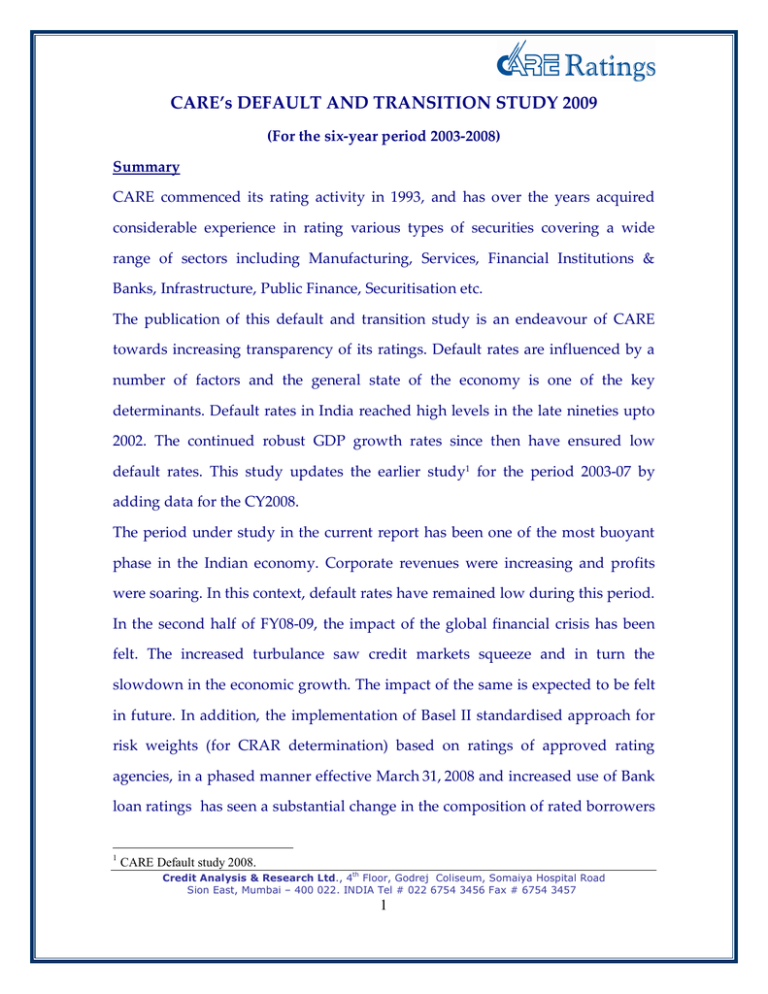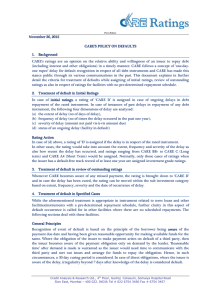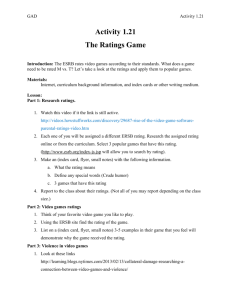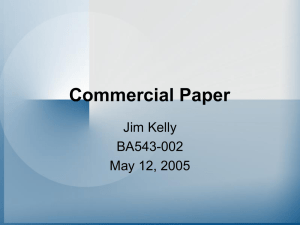CARE’s DEFAULT AND TRANSITION STUDY 2009
advertisement

CARE’s DEFAULT AND TRANSITION STUDY 2009 (For the six-year period 2003-2008) Summary CARE commenced its rating activity in 1993, and has over the years acquired considerable experience in rating various types of securities covering a wide range of sectors including Manufacturing, Services, Financial Institutions & Banks, Infrastructure, Public Finance, Securitisation etc. The publication of this default and transition study is an endeavour of CARE towards increasing transparency of its ratings. Default rates are influenced by a number of factors and the general state of the economy is one of the key determinants. Default rates in India reached high levels in the late nineties upto 2002. The continued robust GDP growth rates since then have ensured low default rates. This study updates the earlier study1 for the period 2003-07 by adding data for the CY2008. The period under study in the current report has been one of the most buoyant phase in the Indian economy. Corporate revenues were increasing and profits were soaring. In this context, default rates have remained low during this period. In the second half of FY08-09, the impact of the global financial crisis has been felt. The increased turbulance saw credit markets squeeze and in turn the slowdown in the economic growth. The impact of the same is expected to be felt in future. In addition, the implementation of Basel II standardised approach for risk weights (for CRAR determination) based on ratings of approved rating agencies, in a phased manner effective March 31, 2008 and increased use of Bank loan ratings has seen a substantial change in the composition of rated borrowers 1 CARE Default study 2008. Credit Analysis & Research Ltd., 4th Floor, Godrej Coliseum, Somaiya Hospital Road Sion East, Mumbai – 400 022. INDIA Tel # 022 6754 3456 Fax # 6754 3457 1 with the increasing sample size across rating categories. The concept of timeliness for repayment for bank loans is somewhat different as compared to bond markets. Avoidance of categorisation as NPA (90 days overdue) is regarded as more critical than timeliness by lenders. Default rates in future may generally rise due to the impact of economic slowdown accompanied by widespread restructuring of loans. CARE’s ratings have shown good discriminatory power across rating categories with higher rated categories generally having lower default rates. However, relatively fewer issuers in each rating category pose limitations to the interpretation of the study results. The Average One-year Transition Rates for CARE rated issuers have shown a high degree of stability and higher rated categories have consistently exhibited higher stability rates. This report presents the default and transition study of CARE rated issuers. Credit Analysis & Research Ltd., 4th Floor, Godrej Coliseum, Somaiya Hospital Road Sion East, Mumbai – 400 022. INDIA Tel # 022 6754 3456 Fax # 6754 3457 2 CARE’s Default Study This section examines default experience of CARE’s long-term and medium-term ratings from December 31, 2002 to December 31, 2008. CARE has used Cohorts method to calculate the performance of CARE rated entities across various rating categories. Category-wise three-year Cumulative Default Rate (CDR) is calculated for the four Cohorts outstanding on December 31, 2002, December 31, 2003, December 31, 2004 and December 31, 2005. Then the issuer weighted average of the three-year CDR of these three Cohorts is computed to arrive at the three-year CDR of each rating category. A higher rating given to an entity implies lower credit risk and should therefore have lower CDR, and CARE’s CDR numbers for December 31, 2002 to December 31 2008, generally display this property. CARE’s definition of default for this CDR study and detailed methodology for computing CDR is presented in Annexure I. The CDR study includes ratings of issuers across all sectors – banks, financial institutions and corporates. Structured Obligations (SO) are not a part of this study which would comprise securitisation transactions, ratings backed by thirdparty guarantees or instruments with a structured payment mechanism. Static Pool / Cohort • The study tracks the long/medium-term ratings assigned and accepted by the issuer and is based on issuer-specific data and not instrument-specific data (thus counting an issuer only once). • The rating of senior-most long-term debt of an issuer is considered as the rating of that issuer. If CARE has not rated the long-term instrument of that issuer, then the medium-term rating is considered as the issuer’s rating. Credit Analysis & Research Ltd., 4th Floor, Godrej Coliseum, Somaiya Hospital Road Sion East, Mumbai – 400 022. INDIA Tel # 022 6754 3456 Fax # 6754 3457 3 • Static pools / Cohorts for the study are the number of issuers outstanding in each rating category as on the four cut-off dates – December 31, 2002, December 31, 2003, December 31, 2004 and December 31, 2005. Default experience of each rating category for each cohort is examined over a three-year period. Rating category-wise sample size is presented below: Table 1: Issuers Outstanding at the beginning of each Cohort period No. of Issuers at the beginning of the cohort period Rating 2003-2005 2004-2006 2005-2007 2006-2008 AAA 8 14 14 19 AA 25 26 36 46 A 18 17 17 23 BBB 13 11 15 16 Below Investment Grade 6 5 4 4 Total 70 73 86 108 CARE’s Three-Year Cumulative Default Rate CARE’s three-year cumulative issuer weighted average default rates (as shown in the tables) are lower in the higher rating categories and increase as we move down the rating categories. There were no instances of default (in any Cohort) in AAA rating category during the period of this study. There was one default in the AA rating category during the period covered in this study and occurred in the earlier cohort of 2003. There are very few issuers in the lower rated categories (BB, B & C). In fact in some cases one or no issuers are present in these rating categories. Also, there are overall sample size limitations for this study. Despite the low absolute number of Credit Analysis & Research Ltd., 4th Floor, Godrej Coliseum, Somaiya Hospital Road Sion East, Mumbai – 400 022. INDIA Tel # 022 6754 3456 Fax # 6754 3457 4 defaults in each category, the default rates show high values as the sample size for the study is relatively small. Table 2: CARE’s Issuer Weighted 3-Year Cumulative Default Rates for the period 2003-2008 Rating Category CDR (%) AAA 0.0 AA 0.8 A 2.7 BBB 7.3 21.1 Below Investment Grade The categories of AA, A, BBB, BB, B and C include ratings with the suffix ‘+’ or ‘–‘ within the respective categories. Thus, for instance, the AA category includes three ratings: AA+, AA and AA-. Observations • Small sample size in all rating categories limits the interpretation of the study results, more-so in the lower rating categories from A, BBB and down below. A single default in the “A” category with a sample size of 17 provides a default rate of 5.88% while in the “BBB” rating category with a sample size of 11, it works out to be 9.09%. In this situation it would be difficult to draw simple conclusions from such a study especially in the lower rated categories. Nevertheless the study is important from drawing broad inferences. As the sample size increases more meaningful conclusions can be reached. • Despite these limitations, it can be observed that CARE’s CDRs display good discriminatory power with higher rating categories generally having lower CDRs. There is no default in the highest rating category for the period 2003-2008. • While structured obligations are not part of this study, CARE has not witnessed any defaults in the asset-backed or mortgage-backed Credit Analysis & Research Ltd., 4th Floor, Godrej Coliseum, Somaiya Hospital Road Sion East, Mumbai – 400 022. INDIA Tel # 022 6754 3456 Fax # 6754 3457 5 securitisation transactions it has rated so far. A major part of CARE’s structured obligation ratings are public finance ratings involving obligations of state level entity backed by state/central government guarantee. Predominantly it has been observed that missed payments on due dates have been of a short-term nature as a result of delays due to compliance with internal government procedure towards making the funds available to the rated entity. Credit Analysis & Research Ltd., 4th Floor, Godrej Coliseum, Somaiya Hospital Road Sion East, Mumbai – 400 022. INDIA Tel # 022 6754 3456 Fax # 6754 3457 6 Transition Study Rating transition study looks at how ratings have changed over a period of time, an important aspect analysed by CARE to evaluate the stability/migration of its ratings. Methodology for transition rates Methodology used by CARE for studying rating transition is discussed below: • The static pools, also known as cohorts, are created by grouping issuer ratings according to the year in which the ratings are active and outstanding at the beginning of the year. • The study tracks the long/medium-term ratings assigned and accepted by the issuer on a year-to-year basis. • The study is based on issuer-specific data and is not instrument-specific. Thus, it counts an issuer only once and avoids distortion. • The transition study includes ratings of issuers across all sectors – banks, financial institutions and corporates. Structured Obligations (SO) are not a part of this study. • Individual cohorts have been formed for each year under study; in all 6 cohorts have been prepared for the 6-year period of study. Each individual cohort for a given calendar year consists of the ratings outstanding in various rating categories at the beginning of the calendar year and tracks the changes in rating, if any, during the one-year period therefrom. For example, the 2008 cohort represents the ratings outstanding as on December 31, 2007 and their transitions or changes (upgrades, downgrades and re-affirmation) in the subsequent year till December 31, 2008. Credit Analysis & Research Ltd., 4th Floor, Godrej Coliseum, Somaiya Hospital Road Sion East, Mumbai – 400 022. INDIA Tel # 022 6754 3456 Fax # 6754 3457 7 • Data from all individual cohorts have been pooled together to obtain the average transition matrix. • The study does not consider withdrawn or suspended ratings nor does it take into its purview the ratings which were no longer in use. The table shows issuer weighted average transition rates on the CARE rating scale over the period 2003-2008. Table 3: Average 1-year Rating Transition Rates for the period CY 2003-2008 (%) Sample Size Rating AAA AA 92 100.00 AAA 0.00 221 0.90 98.19 AA 117 0.00 A 4.27 70 0.00 BBB 0.00 Below Investment Grade * 11 0.00 0.00 A 0.00 0.45 85.47 1.43 9.09 BBB 0.00 0.00 5.98 87.14 0.00 Below Investment Grade 0.00 0.45 4.27 11.43 90.91 * Below Investment Grade; ratings below BBB- (i.e. BB+ till D) The categories of AA, A, BBB, BB, B and C include ratings with the suffix ‘+’ or ‘–‘ within the respective categories. Thus, for instance, the AA category includes three ratings: AA+, AA and AA-. The diagonal of the matrix denotes the percentage of ratings which have been retained whereas the area to the left and right of the diagonal represents upgrades and downgrades, respectively. Based on CARE’s average one-year transition matrix, it can be inferred that out of all the AA rated companies at the beginning of the year, 98.19% have remained at the same category AA at the year ending. Out of the remaining AA rated companies, 0.90% have been upgraded to AAA and 0.45% have been downgraded to A. Similar interpretation can be done for other rating categories as well. Credit Analysis & Research Ltd., 4th Floor, Godrej Coliseum, Somaiya Hospital Road Sion East, Mumbai – 400 022. INDIA Tel # 022 6754 3456 Fax # 6754 3457 8 Upgrades & Downgrades Table 4: Rating Changes Calendar Year 2003 2004 2005 2006 2007 2008 Upgrades 1 4 1 1 1 1 Downgrades 7 2 5 4 4 5 Rating Changes* 8 6 6 5 5 6 *Rating categories include ratings with the suffix ‘+’ or ‘–‘ within the respective categories. Thus, for instance, the AA category includes three ratings: AA+, AA and AA- and the rating changes would not include notching changes like downgrade of AA+ to AA or upgrade of AA- to AA. The absolute numbers of rating upgrades have been less than the downgrades during the period January 2003 to December 2008 with the sole exception of the calendar year 2004. Stability of Ratings Stability rate for each rating category indicates percentage of ratings remaining in the same category at the end of one year. One-year average stability of CARE’s ratings during the period 2003-2008 is presented below: Credit Analysis & Research Ltd., 4th Floor, Godrej Coliseum, Somaiya Hospital Road Sion East, Mumbai – 400 022. INDIA Tel # 022 6754 3456 Fax # 6754 3457 9 Ratings Stability 100.00 100.00 98.19 90.00 85.47 87.14 80.00 70.00 % 60.00 50.00 40.00 30.00 20.00 10.00 0.00 AAA AA A BBB Rating Category • It can be observed from the above chart that CARE’s higher rating categories AAA and AA exhibit high level of stability within one-year period. • Stability rates of CARE’s investment grade higher rating categories have generally been higher than those for the investment grade lower rating categories. Disclaimer CARE has taken due care and caution in compilation of the data for this publication. Information has been taken by CARE from sources it considers accurate and reliable. CARE does not guarantee accuracy, adequacy or completeness of any information and is not responsible for any errors or omissions for the results from the use of such information. CARE especially states that it has no financial liability whatsoever to any use on account of the use of information provided in this publication. This material is not intended as an offer or solicitation for purchase or sale of any financial instruments. CARE’s ratings are opinions on credit quality and are not recommendations to buy, sell or hold any security. CARE has based its ratings on information obtained from sources believed by it to be accurate and reliable. CARE does not, however, guarantee the accuracy, adequacy or completeness of any information and is not responsible for any errors or omissions or for the results obtained from the use of such information. Most issuers of securities rated by CARE have paid a credit rating fee, based on the amount and type of securities issued. Credit Analysis & Research Ltd., 4th Floor, Godrej Coliseum, Somaiya Hospital Road Sion East, Mumbai – 400 022. INDIA Tel # 022 6754 3456 Fax # 6754 3457 10 Annexure I Definition of Default for the Study For the purpose of this study, default has been defined as any missed payment on the rated instrument i.e. a single rupee delay even for a single day has been treated as default. Concept of Static Pool / Cohort Static Pool / Cohort for the study is the number of issuers outstanding in each rating category as on a given date. Default experience of each rating category is examined over the study period. New issuers during the study period are not considered and in that sense the data pool remains static. Companies that withdraw or default during the period remain withdrawn or in default for the remaining years. Therefore, a withdrawn company which is rated again or a company from the pool that defaults and recovers is not considered for reinclusion in that pool. However those entities, which are rated again after withdrawal or which recover from default (and are rated again), are taken as new entities for future static pools. Structured Obligations (SO) are not a part of this study for CDR computation, which would comprise of securitisation transactions, ratings backed by thirdparty guarantees or instruments with a structured payment mechanism. Therefore issuers backed by sovereign or sub-sovereign guarantees do not form a part of this study. Credit Analysis & Research Ltd., 4th Floor, Godrej Coliseum, Somaiya Hospital Road Sion East, Mumbai – 400 022. INDIA Tel # 022 6754 3456 Fax # 6754 3457 11 Cumulative Default Rate (CDR) Cumulative Default Rate (CDR) shows the number of defaults from a given static pool as a proportion of total issuers in that static pool and provides an estimate of default frequency. For a given cohort, three-year CDR is computed as follows: Three-Year CDR = No. of issuers which defaulted over the three-year period / No. of issuers outstanding at the beginning of the three-year period. A hypothetical example is presented here: AAA AA A BBB Opening Issuers (A) Cohort 1 Defaults during next 3 years (B) 50 40 30 20 0 1 2 3 3 Yr CDR = (B/A) (%) 0.00 2.50 6.67 15.00 Opening Issuers (A) Cohort 2 Defaults during next 3 years (B) 60 50 20 15 0 1 2 3 3-Yr CDR = (B/A) (%) 0.00 2.00 10.00 20.00 Issuer weighted average three-year CDR is computed to arrive at the average CDR over a specified period of time. The above example is continued here to arrive at the average CDR: AAA AA A BBB 3 Yr CDR (C1) (%) 0.00 2.50 6.67 15.00 Cohort 1 Opening Issuers (W1) 50 40 30 20 3 Yr CDR (C2) (%) 0.00 2.00 10.00 20.00 Cohort 2 Opening Issuers (W2) 60 50 20 15 Weighted Average 3 Yr CDR =(C1*W1+C2*W2)/(W1+W2) (%) 0.00 2.22 8.00 17.14 Credit Analysis & Research Ltd., 4th Floor, Godrej Coliseum, Somaiya Hospital Road Sion East, Mumbai – 400 022. INDIA Tel # 022 6754 3456 Fax # 6754 3457 12 Analyst Contacts Head Office Rajesh Mokashi Executive Director Tel- +91-22-67543636 rajesh.mokashi@careratings.com Credit Analysis & Research Ltd. 4th Floor, Godrej Coliseum, Somaiya Hospital Road, Sion (East), Mumbai – 400 022. INDIA Tel: 022 – 6754 3456 Regional Office Milind Gadkari Joint General Manager Tel- +91-22-67543466 milind.gadkari@careratings.com -B Wellington Plaza, 90, Anna Salai, Chennai - 600 002 Tel.: (044) 2860 0876 / 2860 7812 710, Surya Kiran, 19, Kasturba Gandhi Marg, New Delhi -01 Tel.: (011) 2331 8701 / 2371 6199 901 & 902, 9th Floor, ‘Shubham bldg, 1, Sarojini Naidu Sarani, Kolkata -017 Tel.: (033) 2283 1800 / 1803 / 2280 8472 307, III Floor, ISCON MALL, Near Jodhpur Cross Road, Satellite Ahmedabad - 380 015 Tel. : (079) 4003 5587 / 6631 1821 / 22 #302, ‘Priya Arcade, 8-3-826, Yellareddyguda Srinagar Colony, Hyderabad - 500 073. Tel.: (040) - 6675 8386, 98491 74030 No. G1, Canopy Royal Manor, Near Manipal Hospital, Rustombagh, Off Airport Road, Bangalore - 560 017 Tel.: (080) - 2520 5575, 9886024430 Credit Analysis & Research Ltd., 4th Floor, Godrej Coliseum, Somaiya Hospital Road Sion East, Mumbai – 400 022. INDIA Tel # 022 6754 3456 Fax # 6754 3457 13




